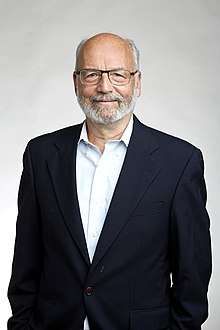Adi Shamir
Adi Shamir (Hebrew: עדי שמיר; born July 6, 1952) is an Israeli cryptographer. He is a co-inventor of the Rivest–Shamir–Adleman (RSA) algorithm (along with Ron Rivest and Len Adleman), a co-inventor of the Feige–Fiat–Shamir identification scheme (along with Uriel Feige and Amos Fiat), one of the inventors of differential cryptanalysis and has made numerous contributions to the fields of cryptography and computer science.[3]
Adi Shamir | |
|---|---|
 Adi Shamir at the Royal Society admissions day in London, July 2018 | |
| Born | July 6, 1952 |
| Alma mater | Tel Aviv University Weizmann Institute of Science |
| Known for | RSA Feige–Fiat–Shamir identification scheme differential cryptanalysis |
| Awards |
|
| Scientific career | |
| Fields | Cryptography |
| Institutions | Weizmann Institute Massachusetts Institute of Technology |
| Thesis | Fixed Points of Recursive Programs and their Relation in Differential Agard Calculus (1977) |
| Doctoral advisor | Zohar Manna[2] |
| Doctoral students | Eli Biham Uriel Feige Amos Fiat[2] |
| Website | www |
Education
Born in Tel Aviv, Shamir received a Bachelor of Science (BSc) degree in mathematics from Tel Aviv University in 1973 and obtained his Master of Science (MSc) and Doctor of Philosophy (PhD) degrees in Computer Science from the Weizmann Institute in 1975 and 1977 respectively.[2]
Career and research
After a year as a postdoctoral researcher at the University of Warwick, he did research at Massachusetts Institute of Technology (MIT) from 1977–1980 before returning to be a member of the faculty of Mathematics and Computer Science at the Weizmann Institute. Starting from 2006, he is also an invited professor at École Normale Supérieure in Paris.
In addition to RSA, Shamir's other numerous inventions and contributions to cryptography include the Shamir secret sharing scheme, the breaking of the Merkle-Hellman knapsack cryptosystem, visual cryptography, and the TWIRL and TWINKLE factoring devices. Together with Eli Biham, he discovered differential cryptanalysis in the late 1980s, a general method for attacking block ciphers. It later emerged that differential cryptanalysis was already known — and kept a secret — by both IBM[4] and the National Security Agency (NSA).[5]
Shamir has also made contributions to computer science outside of cryptography, such as finding the first linear time algorithm for 2-satisfiability[6] and showing the equivalence of the complexity classes PSPACE and IP.
Awards and honors
Shamir has received a number of awards, including the following:
- the 2002 ACM Turing Award, together with Rivest and Adleman, in recognition of his contributions to cryptography[7]
- the Paris Kanellakis Theory and Practice Award;[8]
- the Erdős Prize of the Israel Mathematical Society,
- the 1986 IEEE W.R.G. Baker Award[9]
- the UAP Scientific Prize
- The Vatican's PIUS XI Gold Medal[10]
- the 2000 IEEE Koji Kobayashi Computers and Communications Award[11]
- the Israel Prize, in 2008, for computer sciences.[12][13]
- an honorary DMath (Doctor of Mathematics) degree from the University of Waterloo[14]
- 2017 (33rd) Japan Prize in the field of Electronics, Information and Communication for his contribution to information security through pioneering research on cryptography [15]
- he was elected a Foreign Member of the Royal Society (ForMemRS) in 2018 for substantial contribution to the improvement of natural knowledge.[1]
He was elected a Member of the American Philosophical Society in 2019.
References
- Anon (2018). "Adi Shamir ForMemRS". royalsociety.org. London: Royal Society. Retrieved 2018-07-22. One or more of the preceding sentences incorporates text from the royalsociety.org website where:
"All text published under the heading 'Biography' on Fellow profile pages is available under Creative Commons Attribution 4.0 International License." --Royal Society Terms, conditions and policies at the Wayback Machine (archived 2016-11-11)
- Adi Shamir at the Mathematics Genealogy Project
- Adi Shamir at DBLP Bibliography Server

- Coppersmith, Don (May 1994). "The Data Encryption Standard (DES) and its strength against attacks" (PDF). IBM Journal of Research and Development. 38 (3): 243–250. doi:10.1147/rd.383.0243. Archived (PDF) from the original on 2007-06-15. (subscription required)
- Levy, Steven (2001). Crypto: How the Code Rebels Beat the Government — Saving Privacy in the Digital Age. Penguin Books. pp. 55–56. ISBN 0-14-024432-8.
- Even, S.; Itai, A.; Shamir, A. (1976), "On the complexity of time table and multi-commodity flow problems", SIAM Journal on Computing, 5 (4): 691–703, doi:10.1137/0205048.
- "A. M. Turing Award". Association for Computing Machinery. Archived from the original on 2009-12-12. Retrieved February 5, 2011.
- "Archived copy". Archived from the original on 2009-04-06. Retrieved 2009-02-17.CS1 maint: archived copy as title (link)
- "IEEE W.R.G. Baker Prize Paper Award Recipients" (PDF). IEEE. Archived from the original (PDF) on 2011-04-25. Retrieved February 5, 2011.
- "Pius XI Medal". www.pas.va. Retrieved 2019-02-21.
- "IEEE Koji Kobayashi Computers and Communications Award Recipients" (PDF). IEEE. Archived from the original (PDF) on 2010-11-24. Retrieved February 15, 2011.
- "Israel Prize Official Site (in Hebrew) - Recipient's C.V." Archived from the original on 2012-09-10.
- "Israel Prize Official Site (in Hebrew) - Judges' Rationale for Grant to Recipient". Archived from the original on 2012-09-10.
- "Presentation of the honorary degree at the Fall 2009 Convcation" (PDF). Archived from the original (PDF) on 2011-09-24. Retrieved October 31, 2011.
- "Laureates of the Japan Prize". Archived from the original on 2017-02-04.
| Wikimedia Commons has media related to Adi Shamir. |